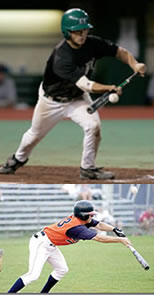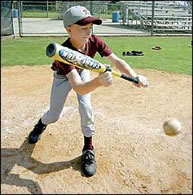Untitled Document
The Art of Bunting
Bunting is an often overlooked, yet vital skill for the complete hitter. Proper execution of this skill can be critical to a teamís success. Advancing runners into scoring position with a sacrifice bunt makes a world of difference in a tight ballgame. So can laying down an unexpected drag bunt single against an especially tough pitcher. Both types of bunts put pressure on the defense and cause reactions that can benefit the offense. The bottom line is that teams that execute the bunt properly will win more of those close 1-run or 2-run games.
Whether your team plays ďsmall ballĒ or relies heavily on home runs and extra base hits, bunting should be part of every playerís daily practice. The reason for this is because you actually are practicing hand-eye coordination at the same time you are practicing your bunting technique. Letís take a look at the proper technique for both the sacrifice bunt and the drag bunt.
 |
2 examples of bad bunting technique. Keep the bat head up, and don't lunge. |
The Sacrifice Bunt
First off, it is a good idea to move up in the box when executing the bunt. This gives you a little more fair territory to work with. Starting in a normal batting stance, the hitter rotates their back foot so that their body is squarely facing the pitcher. At the same time, the top hand should start sliding up the barrel of the bat and moving it into proper position. The top hand should end up about halfway up the barrel, with the bat positioned comfortably between the thumb and index finger. The batter should be in a balanced and comfortable position, with the knees bent. He should also be leaning forward with most of his weight on the front leg.
Bat Angle
The angle and positioning of the bat is critical, and this is where many playersí bunting mechanics break down. The bat should be held out in front of the body, with both elbows bent. The barrel of the bat should be positioned pointing upwards at about a 45 degree angle, at the top of the strike zone. The bat should also be slightly angled forward, again at around a 45 degree angle. Having the bat in this position accomplishes several things:
- It makes it much harder to pop the ball up, the cardinal sin of bunting.
- The angle of the bat is geared toward the left side of the infield, where you want the ball to go in most cases.
- By having the bat head at the top of the strike zone, the hitter knows that if he has to go up to reach the pitch, it is not a pitch he should be attempting to bunt.
 |
This batter has the right idea |
Letís elaborate a bit on this last point and discuss how the hitter should react to different pitch locations. If you are in the proper bunting stance, you should only have to move the bat up or down (not forward or back) in a straight line. Make sure you never drop the bat head. The angle of the bat and the position of your arms should stay constant, and youíll use your knees to adjust to the height of the pitch. And since we know that moving up means moving out of the strike zone, it is really just a matter of bending the knees to adjust to lower pitches. It is very difficult to bunt the low strike by only dropping the hands and not using the knees.
Common mistakes arise from batters going up in the zone and altering the angle of the bat as they do so. This leads to pop ups, fouled bunts, and misses. Another common mistake that I frequently see is lunging at the pitch. Again, straying from the proper bat angle is problematic. It is much harder to make contact and control where the ball goes when you are reaching for a pitch, and you are much more likely to miss the ball completely. Just be patient and let the ball come to you.
So the key to a successful sacrifice bunt is: get in the proper position, use your knees to react to pitches down in the zone and keep the bat angle constant, and avoid pitches that donít fit into your well established position.
The Drag Bunt
The drag bunt, or the threat of a drag bunt, can be an effective tool to spread the defense and put pressure on the third baseman, first baseman and pitcher. You donít have to be the fastest player on your team to utilize it either. Of course speed helps, but your bunting execution matters more. Although the goal is different (to get a base hit), the proper mechanics for the drag bunt are really not much different from the sacrifice bunt. When you are bunting to get on base, the keys are:
- Donít give it away too early
-
Try not to rush your mechanics
- Look for a fastball in the middle or outer half of the strike zone
- Focus on the bunt first, and running second
A successful drag bunt can alter the course of a game significantly. As a coach I often like my players to utilize the drag bunt when the opposing pitcher has been dominant and is not allowing many hits or walks. Also, pay close attention to the third baseman. Is he slow to react? How deep is he playing? Same goes for the pitcher. Does he fall off towards the third base side after his delivery? Answering these questions will help determine if the situation is right for a drag bunt attempt.
Just as with the sacrifice, it is a good idea to move up in the box a little when attempting a drag. Instead of squaring around early, you want to wait until the ball is being released from the pitcherís hand, to keep the element of surprise. Just as with the sacrifice, you only want to bunt a pitch that is a strike - ideally down the middle or on the outside half of the plate. With the drag you really need to bunt the pitch down the third base line or close to it, so having the proper bat angle is even more important in this situation.
The most common problem I see with drag bunting is that batters are so concerned with getting out of the box quickly that it affects their mechanics. Since they are getting ready to sprint to first base, they lose focus on making contact and tend to lunge or ďhackĒ at the pitch.
I tell my players to focus on the executing the bunt first, and running second. When you are squared around in the bunt position, you are already in a good position to explode down the first base line once contact is made, almost like a runner waiting for the starting gun. Bunting the ball accurately down the line is more important than getting a great jump.
Although never as glamorous as hitting a homerun, a successfully executed bunt can also be a game changing event, and can often make the difference between a win and a loss. Make sure you and your teammates take the time to practice the proper mechanics.